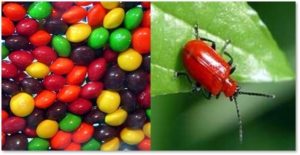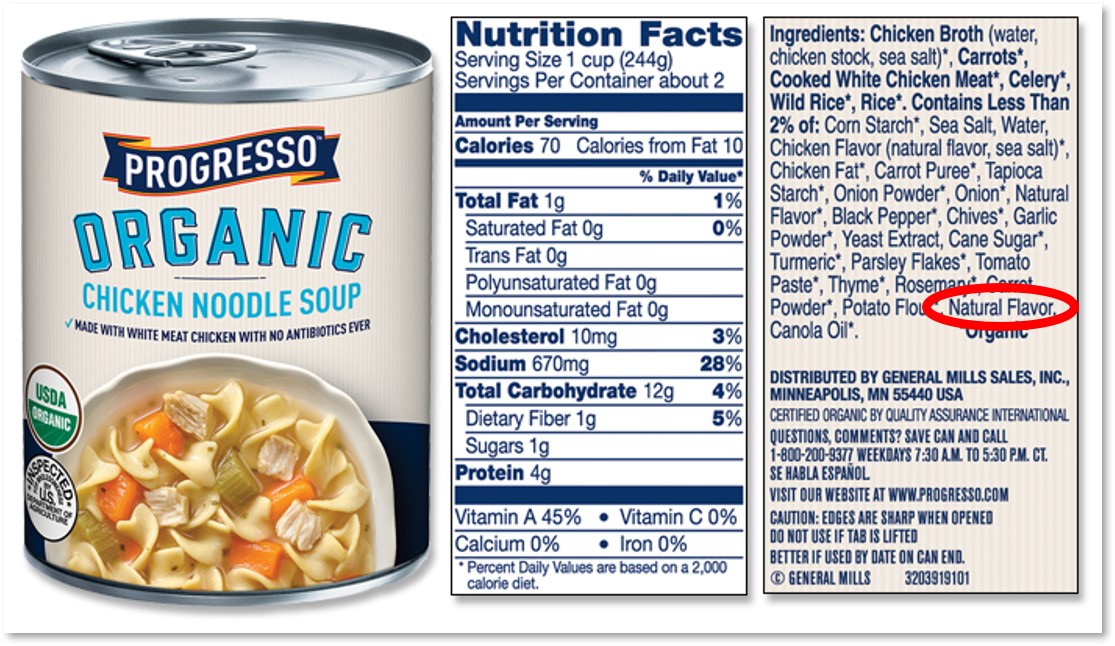If, like me, you read labels before purchasing any processed food, you have seen “Natural Flavor” among the ingredients listed. You probably thought, “Well, that’s okay, then. Natural is good.” So, you put that package in your shopping cart and later popped that food into your mouth without thinking any more about it.
Think again.
Defining Natural Flavors
In its code of Federal Regulations, the U.S. Food and Drug Administration defines “Natural Flavors” as:
“..the essential oil, oleoresin, essence or extractive, protein hydrolysate, distillate, or any product of roasting, heating or enzymolysis, which contains the flavoring constituents derived from a spice, fruit or fruit juice, vegetable or vegetable juice, edible yeast, herb, bark, bud, root, leaf or similar plant material, meat, seafood, poultry, eggs, dairy products, or fermentation products thereof, whose significant function in food is flavoring rather than nutritional” (21CFR101.22).
Got that?
Made in a Laboratory, Not a Kitchen
Aside from the bark and roots thing, those ingredients don’t sound so bad, do they? Perhaps you picture a commercial kitchen with fruits and veggies boiling in a big pot or roasting in an oven before being ground into a powder or made into a paste. For a more accurate picture, envision a high-tech laboratory filled with chemists in white coats. These scientists manipulating these substances to create a product designed to stimulate your appetite or your desire for a certain taste. One that will spike your insulin levels, over-stimulate your cells, or create inflammation.
 At the very least, you may end up eating something that contains substances you are allergic to or that causes a food reaction, a tasty treat that violates your ethical eating standards, or one that would revolt you if you know where it came from. The FDA has declared all this to be perfectly legal.
At the very least, you may end up eating something that contains substances you are allergic to or that causes a food reaction, a tasty treat that violates your ethical eating standards, or one that would revolt you if you know where it came from. The FDA has declared all this to be perfectly legal.
Made for Flavor, Not Nutrition
As the code states, Natural Flavors enhance the flavor of a food; they do not add any nutritional value. They may help to keep it shelf stable or to stay fresh longer but that doesn’t make them good for you.
Scientists called “flavorists” make Natural Flavors in laboratories. These flavorists blend natural chemicals to create specific flavors. If the label says “natural and artificial flavors,” they combined the substances defined above with artificial chemicals. Don’t let the term “chemicals” weird you out, though. All food is made from chemicals, even water. But some substances will gross you out or make you sick.
Good Things to Know About Bad Food
 Things you might want to know about the Natural Flavor in foods you love to eat include these:
Things you might want to know about the Natural Flavor in foods you love to eat include these:
- Your favorite candy has been colored with Cochineal, a dye made from dried and ground female bodies of the scale insect Dactylopius coccus costaa.
- Your favorite shiny candy has been coated with a shellac made from crushed insect cocoons that also give it a nice crunch.
- The vanilla or raspberry flavor in some candies, drinks, desserts and puddings may come from castoreum, a substance secreted by beavers from anal glands and mixed with beaver urine.
- Your vegetarian or vegan food with Natural Flavor may contain meat extracts as well as animal and insect secretions.
- The cystine in commercially produced bread is derived from duck feathers, hog hair, and human hair.
- The sweetness may come from aspartame, which is associated with 92 different medical problems.
Still hungry? The FDA has declared all this trickery to be perfectly legal and the sources don’t have to appear on the label. Don’t look behind the Natural Flavor curtain because you may not like what you find. You may also decide not to buy the product if you know what substances hide behind that catch-all term. Thus, the deception.
Hidden Monosodium Glutamate
Natural Flavors often also contain MSG, which is far worse than sources of merely dubious origin. The food industry uses 40 different names to hide monosodium glutamate, including autolyzed yeast extract, hydrolyzed vegetable (soy, corn, pea) protein, maltodextrin, and sodium caseinate. MSG is an excitotoxin:
“An excitotoxin is a chemical that causes a brain cell to become overexcited and fire uncontrollably, leading to cell death. MSG (and other excitotoxins like aspartame) has the potential for inflicting permanent damage to the brain and nervous system. These chemicals also cross the placental barrier, harming the brains of unborn children.”
MSG heads the list of the six most dangerous excitotoxins.
The Health Impact of MSG
 MSG triples the amount of insulin created by the pancreas, promotes obesity, and can cause brain lesions and neuro-endocrine disorders. MSG has also been linked to migraines, seizures, ADD/ADHD, heart palpitations, tremors, and many other symptoms.
MSG triples the amount of insulin created by the pancreas, promotes obesity, and can cause brain lesions and neuro-endocrine disorders. MSG has also been linked to migraines, seizures, ADD/ADHD, heart palpitations, tremors, and many other symptoms.
When I inadvertently eat some MSG, I get a killer migraine and painful inflammation in my hands that can last for days. I read labels in part to avoid suffering the consequences of trusting the food industry or the FDA.
Fortunately, consumers have become more “woke” to this problem and are rejecting foods that include MSG. Many brands have responded to consumer demand and removed it from their products. Often, the label now states “NO MSG” right on the front. Don’t forget to look on the list of ingredients for Natural Flavor, though. Even when the label says the product is organic. (See the Progresso Organic Chicken Noodle Soup label above.)
Protect Yourself From Natural Flavors
What can you do to avoid natural flavors? Start with these seven approaches:
- Real the labels on any processed food, including mayonnaise, ketchup, breakfast cereal, canned soup, yogurt, salad dressings, tomato sauce, ramen noodles, and bread. Don’t believe any claims on the front of the label until you check the ingredients on the back. Even when it claims to be organic.
- Remember that the food industry uses multiple names to hide excitotoxins. The Real Food/Whole Health web site has a list of terms and ingredients to avoid.
- If it says “Natural Flavor” or, worse, “Natural and Synthetic Flavor,” don’t buy it. Just. Don’t. Buy. It. Eventually the manufacturer will get the message.
- If you get a headache, a rash, or painful inflammation, make a note of what you just ate. Avoid that food or that brand in the future.
- If you eat a prepared food that explodes with flavor or with sweetness in your mouth, it probably contains MSG or aspartame.
- Choose Chinese restaurants that don’t use MSG. You will get some anyway from soy sauce, fish sauce and other processed ingredients. Order lightly cooked dishes with few sauces to mitigate this.
- Eat as many whole foods as you can. That means fresh fruit, vegetables, nuts, and grains that don’t need ingredient lists. If you eat meat, chicken and fish, buy them fresh and unprocessed or pre-cooked.
The Food and Drug Administration does a lot of good things to keep the American public healthy but it is subject to political influence, as in the case of aspartame’s approval. Be diligent and trust your own judgment. Your body will thank you.
Checking the Cupboard
NOTE: After writing this, I went to the cupboard and looked at my boxes of Kitchen Basics beef stock. I had cleared Kitchen Basics stocks for MSG years ago and use them for everything from rice pilaf to beef stew. Alas, there it was: Natural Flavor. These two boxes will go to the Food Pantry and I will read labels of competing products the next time I’m in the supermarket.


First of all I would like to say excellent blog! I had a quick question which I’d like to ask if you do not
mind. I was interested to find out how you center yourself and
clear your thoughts prior to writing. I have had trouble clearing my
thoughts in getting my thoughts out. I truly do take pleasure in writing but it just seems like the
first 10 to 15 minutes tend to be lost just trying to figure out
how to begin. Any ideas or hints? Appreciate it!